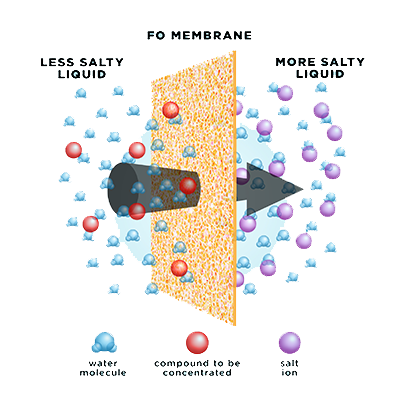 Forward Osmosis FO is a “green” technology that uses a semi-permeable membrane to separate water from dissolved solids. In nature, plants and trees draw water into their roots by osmosis. FO is powered by natural osmosis, as the solvents in the water seek the area of higher solute concentration on the other side of the membrane (see diagram below).
Forward Osmosis FO is a “green” technology that uses a semi-permeable membrane to separate water from dissolved solids. In nature, plants and trees draw water into their roots by osmosis. FO is powered by natural osmosis, as the solvents in the water seek the area of higher solute concentration on the other side of the membrane (see diagram below).
Unlike the high-pressure-driven Reverse Osmosis (RO) process, Forward Osmosis pulls water molecules through the membrane via osmotic pressure differences, and does not require the external pump or hydraulic pressure that RO does. For this reason, FO systems are better suited for filtering high-fouling feed streams, enabling FO to be used as a complementary pretreatment process to pressure-driven membrane filtration.
Forward Osmosis is ideal for industrial applications where wastewaters and other feed streams containing a high level of suspended solids and high salinity need to be filtered or concentrated. These challenges typically cannot be resolved with a single filtration process.
Forward Osmosis, through the process of natural osmosis, can dewater waste streams that typically require extensive pretreatment. Since numerous pretreatment steps are avoided, CAPEX and OPEX are reduced. FO membranes are highly fouling-resistant, ensuring extended membrane service life and lower OPEX. When fouling does occur, simple backwashing and flushing removes foulants and restores membrane performance.

